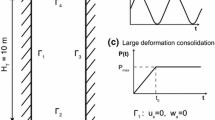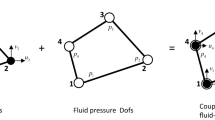Abstract
An accurate and efficient low-order quadrilateral mixed u–p element suitable for dynamic analysis of fluid saturated porous media is presented. The element uses physical hourglass stabilization to facilitate single-point integration for the solid phase, and non-residual stabilization of the fluid phase to circumvent instability in the incompressible-impermeable limit due to the use of equal-order interpolation for the displacement and pressure fields. Element behavior is verified and demonstrated through several numerical examples.













Similar content being viewed by others
References
Bathe KJ (1996) Finite element procedures. Prentice Hall, Upper Saddle River
Belytschko T, Bachrach WE (1986) Efficient implementation of quadrilaterals with high coarse-mesh accuracy. Comput Methods Appl Mech Eng 54:279–301
Belytschko T, Bindeman LP (1991) Assumed strain stabilization of the 4-node quadrilateral with 1-point quadrature for nonlinear problems. Comput Methods Appl Mech Eng 88:311–340
Belytschko T, Bindeman LP (1993) Assumed strain stabilization of the eight node hexahedral element. Comput Methods Appl Mech Eng 105:225–260
Belytschko T, Ong JS, Liu WK, Kennedy JM (1984) Hourglass control in linear and nonlinear problems. Comput Methods Appl Mech Eng 43:251–276
Belytschko T, Liu WK, Moran B (2000) Nonlinear finite elements for continua and structures. Wiley, West Sussex
Biot MA (1941) General theory of three dimensional consolidation. J Appl Phys 12:155–164
Biot MA (1956) Theory of propagation of elastic waves in a fluid saturated porous solid. J Acoust Soc Am 28:168–191
Biot MA (1962) Mechanics of deformation and acoustic propagation in porous media. J Appl Phys 33:1482–1498
Bochev PB, Dohrmann CR, Gunzburger MD (2006) Stabilization of low-order mixed finite elements for the Stokes equations. SIAM J Numer Anal 44(1):82–101
Brezzi F, Fortin M (1991) Mixed and hybrid finite element methods. Springer, New York
Brezzi F, Pitäkaranta J (1984) On the stabilization of finite element approximations of the Stokes problem. In: Hackbusch W (eds) Efficient solutions of elliptic systems, notes on numerical fluid mechanics, Vieweg, Braunschweig, pp 11–19
Commend S, Truty A, Zimmermann T (2004) Stabilized finite elements applied to elastoplasticity: I. Mixed displacement-pressure formulation. Comput Methods Appl Mech Eng 193:3559–3586
Elgamal A, Yang Z, Parra E, Ragheb A (2003) Modeling of cyclic mobility in saturated cohesionless soils. Int J Plast 19:883–905
Flanagan DP, Belytschko T (1981) A uniform strain hexahedron and quadrilateral with orthogonal hourglass control. Int J Numer Methods Eng 17:679–706
Huang M, Wu S, Zienkiewicz OC (2001) Incompressible or nearly incompressible soil dynamic behavior—a new staggered algorithm to circumvent restrictions of mixed formulation. Soil Dyn Earthq Eng 21:169–179
Huang M, Yue ZQ, Tham LG, Zienkiewicz OC (2004) On the stable finite element procedures for dynamic problems of saturated porous media. Int J Numer Methods Eng 61:1421–1450
Hughes TJR (1995) Multiscale phenomena: Green’s functions, the Dirichlet to Neumann formulation, subgrid scale models, bubbles and the origin of stabilized methods. Comput Methods Appl Mech Eng 127:387–401
Hughes TJR, Franca LP, Balestra M (1986) A new finite element formulation for computational fluid dynamics: V. Circumventing the Babuška-Brezzi condition: a stable Petrov-Galerkin formulation of the Stokes problem accommodating equal-order interpolations. Comput Methods Appl Mech Eng 59:85–99
Hughes TJR, Feijóo GR, Mazzei L, Quincy JB (1998) The variational multiscale method—a paradigm for computational mechanics. Comput Methods Appl Mech Eng 186:3–24
Jacquotte OP, Oden JT (1984) Analysis of hourglass instabilities and control in underintegrated finite element methods. Comput Methods Appl Mech Eng 44:339–363
Joyner WB, Chen ATF (1975) Calculation of nonlinear ground response in earthquakes. Bull Seismol Soc Am 65(5):1315–1336
Lysmer J, Kuhlemeyer AM (1969) Finite dynamic model for infinite media. J Eng Mech Div ASCE 95:859–877
Newmark NM (1959) A method of computation for structural dynamics. J Eng Mech Div ASCE 85(EM3):67–94
PEER ground motion database (2010) PEER ground motion database for shallow crustal earthquakes in active tectonic regimes. http://peer.berkeley.edu/peer_ground_motion_database. Pacific Earthquake Engineering Research Center, University of California, Berkeley
Prevost JH (1982) Nonlinear transient phenomena in saturated porous media. Comput Methods Appl Mech Eng 30:3–8
Prevost JH (1985) A simple plasticity theory for frictional cohesionless soils. Soil Dyn Earthq Eng 4:9–17
Prevost JH (1985) Wave propagation in fluid-saturated porous media: An efficient finite element procedure. Soil Dyn Earthq Eng 4:183–202
Reese S (2003) On a consistent hourglass stabilization technique to treat large inelastic deformations and thermo-mechanical coupling in plane strain problems. Int J Numer Methods Eng 57:1095–1127
Reese S (2005) On a physically stabilized one point finite element formulation for three-dimensional finite elasto-plasticity. Comput Methods Appl Mech Eng 194:4685–4715
Timoshenko S, Goodier JN (1951) Theory of Elasticity. 2nd edn. McGraw-Hill Book Company, Inc., New York
Truty A (2001) A galerkin/least-squares finite element formulation for consolidation. Int J Numer Methods Eng 52:763–786
Truty A, Zimmermann T (2006) Stabilized mixed finite element formulations for materially nonlinear partially saturated two-phase media. Comput Methods Appl Mech Eng 195:1517–1546
Wan J (2002) Stabilized finite element methods for coupled geomechanics and multiphase flow. Ph.D. Dissertation, Stanford University
White JA, Borja RI (2008) Stabilized low-order finite elements for coupled solid-deformation/fluid-diffusion and their application to fault zone transients. Comput Methods Appl Mech Eng 197:4353–4366
Wissmann JW, Becker T, Möller H (1987) Stabilization of the zero-energy modes of under-integrated isoparametric finite elements. Comput Mech 2:289–306
Wriggers P (2008) Nonlinear finite element methods. Springer, Berlin
Xia K, Masud A (2009) A stabilized finite element formulation for finite deformation elastoplasticity in geomechanics. Comput Geotech 36:396–405
Zienkiewicz OC (1981) Basic formulation of static and dynamic behavior of soil and other porous media. In: Martins JB (eds) Numerical Methods in Geomechanics, D. Reidel Publishing Company, Dordrecht
Zienkiewicz OC, Shiomi T (1984) Dynamic behavior of saturated porous media; the generalized Biot formulation and its numerical solution. Int J Numer Methods Geomech 8:71–96
Zienkiewicz OC, Huang M, Pastor M (1994) Computational soil dynamics—a new algorithm for drained and undrained conditions. In: Siriwardane HJ, Zaman MM (eds) Computer methods and advances in geomechanics, A.A. Balkema, Rotterdam, pp 47–59
Zienkiewicz OC, Taylor RL, Zhu JZ (2005) The finite element method—its basis and fundamentals. 6th edn. Elsevier Butterworth-Heinemann, Oxford
Author information
Authors and Affiliations
Corresponding author
Rights and permissions
About this article
Cite this article
McGann, C.R., Arduino, P. & Mackenzie-Helnwein, P. Stabilized single-point 4-node quadrilateral element for dynamic analysis of fluid saturated porous media. Acta Geotech. 7, 297–311 (2012). https://doi.org/10.1007/s11440-012-0168-5
Received:
Accepted:
Published:
Issue Date:
DOI: https://doi.org/10.1007/s11440-012-0168-5




